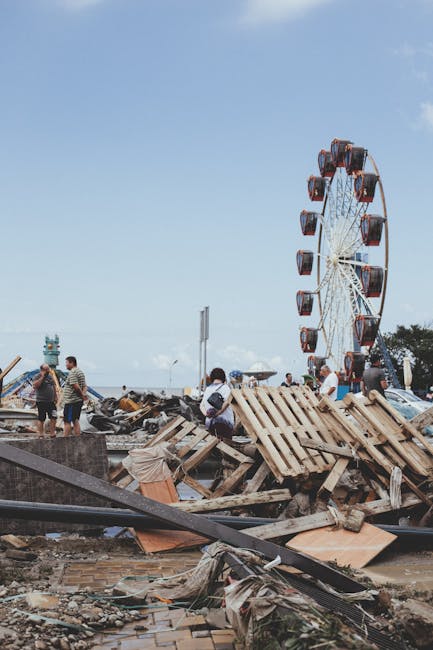St. Louis Tornado Relief: Navigating the Aftermath and Path to Recovery
St. Louis Tornado Relief: Navigating the Aftermath and Path to Recovery
The devastating tornadoes that ripped through the St. Louis metropolitan area left a trail of destruction in their wake, impacting countless lives and livelihoods. The immediate aftermath brought chaos and fear, but the spirit of the community shone through as neighbors helped neighbors, and the collective effort to rebuild began. This comprehensive guide delves into the multifaceted aspects of St. Louis tornado relief, providing essential information for those affected and those looking to contribute to the recovery effort.
Immediate Needs and Emergency Response
In the immediate aftermath of a tornado, ensuring safety and meeting basic needs is paramount. Emergency services, including fire departments, police, and paramedics, played a critical role in search and rescue operations, providing medical assistance to the injured, and securing the affected areas. The American Red Cross and other non-profit organizations established temporary shelters, providing food, water, shelter, and essential supplies to those displaced from their homes.
The initial response also involved assessing the extent of the damage, identifying critical infrastructure needs, and coordinating resources for immediate relief. This included clearing debris, restoring power, ensuring access to clean water, and providing temporary housing solutions. The speed and efficiency of the initial response were critical in minimizing further suffering and setting the stage for a more comprehensive recovery effort.

Accessing Emergency Assistance
- American Red Cross: The Red Cross provides shelter, food, clothing, and other essential services to disaster victims. Their website and local chapters are key resources for immediate assistance.
- FEMA (Federal Emergency Management Agency): FEMA offers a range of disaster assistance programs, including grants for temporary housing, home repairs, and other disaster-related expenses.
- Local Government Agencies: City and county governments often establish emergency response centers and provide information on available resources and assistance programs.
- Community Organizations: Numerous local organizations and churches mobilized to provide support, offering everything from food and clothing to counseling and emotional support.
Long-Term Recovery and Rebuilding
The path to long-term recovery after a tornado is a complex and lengthy process. It involves not just rebuilding physical infrastructure but also addressing the emotional and psychological impacts on individuals and communities. This phase requires sustained effort from all stakeholders, including government agencies, non-profit organizations, businesses, and individuals.
Housing and Home Repair
The destruction of homes is often the most significant consequence of a tornado. Rebuilding or repairing damaged homes requires significant financial resources and expertise. FEMA and other government programs offer assistance, but navigating the application process and securing funding can be challenging. Many community organizations also provide assistance with home repairs and rebuilding, often employing volunteers and skilled contractors.

Financial Assistance and Insurance Claims
Dealing with insurance claims after a tornado can be a frustrating and time-consuming process. It’s crucial to document all damages with photos and videos and to keep meticulous records of all communication with insurance companies. Many individuals and families also need financial assistance beyond insurance coverage, and accessing government grants, loans, and charitable donations can be vital for recovery.
Mental Health and Emotional Support
The emotional toll of a tornado can be significant. Many survivors experience trauma, anxiety, depression, and other mental health challenges. Access to mental health services is crucial for recovery, and community organizations often provide counseling and support groups. It’s essential to recognize the importance of seeking help and support during this difficult time.
Community Support and Volunteer Opportunities
The response to the St. Louis tornadoes highlighted the remarkable resilience and generosity of the community. Countless individuals and organizations volunteered their time and resources to assist those affected. From clearing debris to providing meals and emotional support, the outpouring of community support played a critical role in the recovery process.
Volunteering Your Time and Skills
If you’re looking to contribute to the relief effort, there are numerous opportunities to volunteer your time and skills. Many organizations coordinate volunteer efforts, matching volunteers with specific needs. Skills ranging from construction and carpentry to counseling and administrative support are needed in the recovery process. Even small acts of kindness, such as providing meals or offering emotional support, can make a significant difference.
Donating to Relief Organizations
Financial donations are crucial for supporting long-term recovery efforts. Many reputable charities and non-profit organizations are actively involved in St. Louis tornado relief, and donating to these organizations ensures that your contribution reaches those who need it most. It’s essential to research organizations carefully to ensure that your donation goes to a legitimate and effective organization.
Lessons Learned and Future Preparedness
The St. Louis tornadoes serve as a stark reminder of the devastating power of nature and the importance of preparedness. Lessons learned from this event can inform future disaster response and mitigation efforts. This includes improving early warning systems, strengthening building codes, and enhancing community preparedness plans. Investing in infrastructure resilience and community education is critical in reducing the impact of future disasters.
Improving Early Warning Systems
Effective early warning systems are crucial for minimizing loss of life and property damage. Improving the accuracy and timeliness of tornado warnings and enhancing public awareness of warning signals are essential for preparedness. Investing in advanced weather monitoring technology and developing effective communication strategies can significantly improve the effectiveness of early warning systems.
Strengthening Building Codes and Infrastructure
Building codes play a critical role in protecting communities from the destructive forces of tornadoes. Strengthening building codes to require more resilient construction techniques and materials can significantly reduce damage to homes and businesses. Investing in infrastructure improvements, including strengthening power grids and transportation networks, is also essential for a more resilient community.
Community Preparedness and Education
Community preparedness is vital for effectively responding to and recovering from disasters. Educating the public about tornado safety, including developing personal emergency plans and establishing community-wide communication networks, is essential. Regular disaster drills and preparedness exercises can help communities to respond more effectively in the event of a tornado or other disaster.

The St. Louis tornado relief effort demonstrates the power of community spirit and collective action. By working together, we can rebuild stronger and more resilient communities prepared for future challenges.







